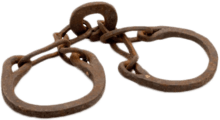Uncle Tom's Cabin
Uncle Tom's Cabin; or, Life Among the Lowly[1][2] is an anti-slavery novel by American author Harriet Beecher Stowe. Published in 1852, the novel had a profound effect on attitudes toward African Americans and slavery in the U.S. and is said to have "helped lay the groundwork for the Civil War".[3]
 Title page for Volume I of the first edition of Uncle Tom's Cabin (1852) | |
| Author | Harriet Beecher Stowe |
|---|---|
| Original title | Uncle Tom's Cabin; or, Life Among the Lowly |
| Illustrator | Hammatt Billings |
| Country | United States |
| Language | English |
| Genre | Novel |
| Published | 1852 (two volumes) |
| Publisher | John P. Jewett and Company, after serialization in The National Era beginning June 5, 1851 |
| OCLC | 1077982310 |
| 813.3 | |
| LC Class | PS2954 .U5 |
| Followed by | A Key to Uncle Tom's Cabin |
Stowe, a Connecticut-born teacher at the Hartford Female Seminary and an active abolitionist, featured the character of Uncle Tom, a long-suffering black slave around whom the stories of other characters revolve. The sentimental novel depicts the reality of slavery while also asserting that Christian love can overcome something as destructive as enslavement of fellow human beings.[4][5][6]
Uncle Tom's Cabin was the best-selling novel of the 19th century and the second best-selling book of that century, following the Bible.[7][8] It is credited with helping fuel the abolitionist cause in the 1850s.[9] In the first year after it was published, 300,000 copies of the book were sold in the United States; one million copies in Great Britain.[10] In 1855, three years after it was published, it was called "the most popular novel of our day."[11] The impact attributed to the book is great, reinforced by a story that when Abraham Lincoln met Stowe at the start of the Civil War, Lincoln declared, "So this is the little lady who started this great war."[12] The quote is apocryphal; it did not appear in print until 1896, and it has been argued that "The long-term durability of Lincoln's greeting as an anecdote in literary studies and Stowe scholarship can perhaps be explained in part by the desire among many contemporary intellectuals ... to affirm the role of literature as an agent of social change."[13]
The book and the plays it inspired helped popularize a number of stereotypes about black people.[14] These include the affectionate, dark-skinned "mammy"; the "pickaninny" stereotype of black children; and the "Uncle Tom", or dutiful, long-suffering servant faithful to his white master or mistress. In recent years, the negative associations with Uncle Tom's Cabin have, to an extent, overshadowed the historical impact of the book as a "vital antislavery tool."[15]
Sources
Stowe, a Connecticut-born teacher at the Hartford Female Seminary and an active abolitionist, wrote the novel as a response to the passage, in 1850, of the second Fugitive Slave Act. Much of the book was composed in Brunswick, Maine, where her husband, Calvin Ellis Stowe, taught at his alma mater, Bowdoin College.
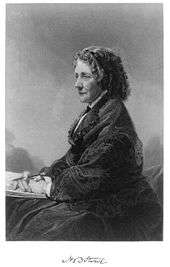
Stowe was partly inspired to create Uncle Tom's Cabin by the slave narrative The Life of Josiah Henson, Formerly a Slave, Now an Inhabitant of Canada, as Narrated by Himself (1849). Henson, a formerly enslaved black man, had lived and worked on a 3,700-acre (15 km2) tobacco plantation in North Bethesda, Maryland, owned by Isaac Riley.[16] Henson escaped slavery in 1830 by fleeing to the Province of Upper Canada (now Ontario), where he helped other fugitive slaves settle and become self-sufficient, and where he wrote his memoirs. Stowe acknowledged in 1853 that Henson's writings inspired Uncle Tom's Cabin.[17] When Stowe's work became a best-seller, Henson republished his memoirs as The Memoirs of Uncle Tom and traveled on lecture tours extensively in the United States and Europe.[16] Stowe's novel lent its name to Henson's home—Uncle Tom's Cabin Historic Site, near Dresden, Ontario, Canada—which since the 1940s has been a museum. The cabin where Henson lived while he was enslaved no longer exists, but a cabin on the Riley farm erroneously thought to be the Henson Cabin was purchased by the Montgomery County, Maryland, government in 2006.[18] It is now a part of the National Park Service National Underground Railroad Network to Freedom program,[19] and plans are underway to build a museum and interpretive center on the site.
American Slavery as It Is: Testimony of a Thousand Witnesses, a volume co-authored by Theodore Dwight Weld and the Grimké sisters, is also a source of some of the novel's content.[20] Stowe said she based the novel on a number of interviews with people who escaped slavery during the time when she was living in Cincinnati, Ohio, across the Ohio River from Kentucky, a slave state. In Cincinnati the Underground Railroad had local abolitionist sympathizers and was active in efforts to help runaway slaves on their escape route from the South.
Stowe mentioned a number of the inspirations and sources for her novel in A Key to Uncle Tom's Cabin (1853). This non-fiction book was intended to verify Stowe's claims about slavery.[21] However, later research indicated that Stowe did not read many of the book's cited works until after she had published her novel.[21]
Publication

Uncle Tom's Cabin first appeared as a 40-week serial in The National Era, an abolitionist periodical, starting with the June 5, 1851, issue. It was originally intended as a shorter narrative that would run for only a few weeks. Stowe expanded the story significantly, however, and it was instantly popular, such that several protests were sent to the Era office when she missed an issue.[22] Because of the story's popularity, the publisher John P. Jewett contacted Stowe about turning the serial into a book. While Stowe questioned if anyone would read Uncle Tom's Cabin in book form, she eventually consented to the request.
Convinced the book would be popular, Jewett made the unusual decision (for the time) to have six full-page illustrations by Hammatt Billings engraved for the first printing.[23] Published in book form on March 20, 1852, the novel sold 3,000 copies on that day alone,[22] and soon sold out its complete print run. A number of other editions were soon printed (including a deluxe edition in 1853, featuring 117 illustrations by Billings).[24]
In the first year of publication, 300,000 copies of Uncle Tom's Cabin were sold. At that point, however, "demand came to an unexpected halt.... No more copies were produced for many years, and if, as is claimed, Abraham Lincoln greeted Stowe in 1862 as 'the little woman who wrote the book that made this great war,' the work had effectively been out of print for many years." Jewett went out of business, and it was not until Ticknor and Fields put the work back in print in November 1862 that demand began again to increase.[25]
The book was translated into all major languages, and in the United States it became the second best-selling book after the Bible.[7] A number of the early editions carried an introduction by Rev James Sherman, a Congregational minister in London noted for his abolitionist views. Uncle Tom's Cabin sold equally well in Britain, with the first London edition appearing in May 1852 and selling 200,000 copies.[26] In a few years over 1.5 million copies of the book were in circulation in Britain, although most of these were infringing copies (a similar situation occurred in the United States).[27]
Plot
Eliza escapes with her son; Tom sold "down the river"

The book opens with a Kentucky farmer named Arthur Shelby facing the loss of his farm because of debts. Even though he and his wife Emily Shelby believe that they have a benevolent relationship with their slaves, Shelby decides to raise the needed funds by selling two of them—Uncle Tom, a middle-aged man with a wife and children, and Harry, the son of Emily Shelby's maid Eliza—to Mr. Haley, a coarse slave trader. Emily Shelby is averse to this idea because she had promised her maid that her child would never be sold; Emily's son, George Shelby, hates to see Tom go because he sees the man as his friend and mentor.
When Eliza overhears Mr. and Mrs. Shelby discussing plans to sell Tom and Harry, Eliza determines to run away with her son. The novel states that Eliza made this decision because she fears losing her only surviving child (she had already miscarried two children). Eliza departs that night, leaving a note of apology to her mistress.
As Tom is sold, Mr. Haley takes him to a riverboat on the Mississippi River and from there Tom is to be transported to a slave market. While on board, Tom meets Eva, an angelic little white girl and quickly they become friends. Eva falls into the river and Tom dives into the river to save her life. Being grateful to Tom, Eva's father Augustine St. Clare buys him from Haley and takes him with the family to their home in New Orleans. Tom and Eva begin to relate to one another because of the deep Christian faith they both share.
Eliza's family hunted; Tom's life with St. Clare
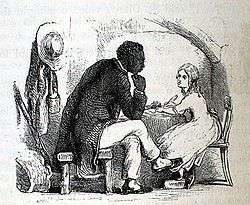
During Eliza's escape, she meets up with her husband George Harris, who had run away previously. They decide to attempt to reach Canada. However, they are tracked by Tom Loker, a slave hunter hired by Mr. Haley. Eventually Loker and his men trap Eliza and her family, causing George to shoot him in the side. Worried that Loker may die, Eliza convinces George to bring the slave hunter to a nearby Quaker settlement for medical treatment.
Back in New Orleans, St. Clare debates slavery with his Northern cousin Ophelia who, while opposing slavery, is prejudiced against black people. St. Clare, however, believes he is not biased, even though he is a slave owner. In an attempt to show Ophelia that her views on blacks are wrong, St. Clare purchases Topsy, a young black slave, and asks Ophelia to educate her.
After Tom has lived with the St. Clares for two years, Eva grows very ill. Before she dies she experiences a vision of heaven, which she shares with the people around her. As a result of her death and vision, the other characters resolve to change their lives, with Ophelia promising to throw off her personal prejudices against blacks, Topsy saying she will better herself, and St. Clare pledging to free Tom.
Tom sold to Simon Legree
Before St. Clare can follow through on his pledge, however, he dies after being stabbed outside a tavern. His wife reneges on her late husband's vow and sells Tom at auction to a vicious plantation owner named Simon Legree. Tom is taken to rural Louisiana with other new slaves including Emmeline whom Simon Legree has purchased to use as a sex slave.
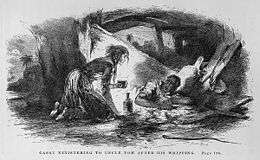
Legree begins to hate Tom when Tom refuses Legree's order to whip his fellow slave. Legree beats Tom viciously and resolves to crush his new slave's faith in God. Despite Legree's cruelty, however, Tom refuses to stop reading his Bible and comforting the other slaves as best he can. While at the plantation, Tom meets Cassy, another slave whom Legree used as sex slave. Cassy tells her story to Tom. She was previously separated from her son and daughter when they were sold. She became pregnant again but killed the child as she could not stand to have another child separated from her.
At this point Tom Loker returns to the story. Loker has changed as the result of being healed by the Quakers. George, Eliza, and Harry have also obtained their freedom as Tom Loker helped them to crossover into Canada from Lake Erie. In Louisiana, Uncle Tom almost succumbs to hopelessness as his faith in God is tested by the hardships of the plantation. However, he has two visions, one of Jesus and one of Eva, which renew his resolve to remain a faithful Christian, even unto death. He encourages Cassy to escape, which she does, taking Emmeline with her. When Tom refuses to tell Legree where Cassy and Emmeline have gone, Legree orders his overseers to kill Tom. As Tom is dying, he forgives the overseers who savagely beat him. Humbled by the character of the man they have killed, both men become Christians. Very shortly before Tom's death, George Shelby (Arthur Shelby's son) arrives to buy Tom's freedom but finds he is too late.
Final section
On their boat ride to freedom, Cassy and Emmeline meet George Harris' sister Madame de Thoux and accompany her to Canada. Madame de Thoux and George Harris were separated in their childhood. Cassy discovers that Eliza is her long-lost daughter who was sold as a child. Now that their family is together again, they travel to France and eventually Liberia, the African nation created for former American slaves. George Shelby returns to the Kentucky farm, where after his father's death, he frees all his slaves. George Shelby urges them to remember Tom's sacrifice every time they look at his cabin. He decides to lead a pious christian life just as Uncle Tom did.
Major characters
Uncle Tom
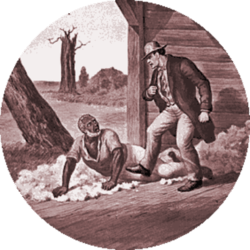
Uncle Tom, the title character, was initially seen as a noble, long-suffering Christian slave. In more recent years, however, his name has become an epithet directed towards African-Americans who are accused of selling out to whites. Stowe intended Tom to be a "noble hero"[28] and praiseworthy person. Throughout the book, far from allowing himself to be exploited, Tom stands up for his beliefs and is grudgingly admired even by his enemies.
Eliza
Eliza is a slave and personal maid to Mrs. Shelby who escapes to the North with her five-year-old son Harry after he is sold to Mr. Haley. Her husband, George, eventually finds Eliza and Harry in Ohio and emigrates with them to Canada, then France and finally Liberia.
The character Eliza was inspired by an account given at Lane Theological Seminary in Cincinnati by John Rankin to Stowe's husband Calvin, a professor at the school. According to Rankin, in February 1838 a young slave woman, Eliza Harris, had escaped across the frozen Ohio River to the town of Ripley with her child in her arms and stayed at his house on her way further north.[29]
Eva
Evangeline St. Clare is the daughter of Augustine St. Clare. Eva enters the narrative when Uncle Tom is traveling via steamship to New Orleans to be sold, and he rescues the five- or six-year-old girl from drowning. Eva begs her father to buy Tom, and he becomes the head coachman at the St. Clare house. He spends most of his time with the angelic Eva. Eva often talks about love and forgiveness, convincing the dour slave girl Topsy that she deserves love. She even touches the heart of her Aunt Ophelia.
Eventually Eva falls terminally ill. Before dying, she gives a lock of her hair to each of the slaves, telling them that they must become Christians so that they may see each other in Heaven. On her deathbed, she convinces her father to free Tom, but because of circumstances the promise never materializes.
A similar character, also named Little Eva, later appeared in the children's novel Little Eva: The Flower of the South by Philip J. Cozans—although this ironically was an anti-Tom novel.
Simon Legree
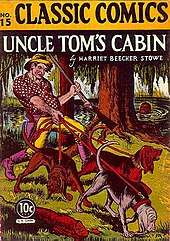
Simon Legree is a cruel slave owner—a Northerner by birth—whose name has become synonymous with greed. He is arguably the novel's main antagonist. His goal is to demoralize Tom and break him of his religious faith; he eventually orders Tom whipped to death out of frustration for his slave's unbreakable belief in God. The novel reveals that, as a young man, he had abandoned his sickly mother for a life at sea and ignored her letter to see her one last time at her deathbed. He sexually exploits Cassy, who despises him, and later sets his designs on Emmeline.
It is unclear if Legree is based on any actual individuals. Reports surfaced after the 1870s that Stowe had in mind a wealthy cotton and sugar plantation owner named Meredith Calhoun, who settled on the Red River north of Alexandria, Louisiana. Generally, however, the personal characteristics of Calhoun ("highly educated and refined") do not match the uncouthness and brutality of Legree. Calhoun even edited his own newspaper, published in Colfax (originally "Calhoun's Landing"), which was renamed The National Democrat after Calhoun's death. However, Calhoun's overseers may have been in line with the hated Legree's methods and motivations.[30]
Other characters
These are the more notable of the secondary and minor characters in Uncle Tom's Cabin:
- Arthur Shelby – Tom's master in Kentucky. Shelby is characterized as a "kind" slaveowner and a stereotypical Southern gentleman.
- Emily Shelby – Arthur Shelby's wife. She is a deeply religious woman who strives to be a kind and moral influence upon her slaves and is appalled when her husband sells his slaves with a slave trader. As a woman, she has no legal way to stop this, as all property belongs to her husband.
- George Shelby – Arthur's and Emily's son, who sees Tom as a friend and as the perfect Christian.
- Chloe – Tom's wife and mother of his children.
- Augustine St. Clare – Tom's third owner and father of Eva. St. Clare is complex, often sarcastic, with a ready wit. After a rocky courtship he marries a woman he grows to hold in contempt, though he is too polite to let it show. St. Clare recognizes the evil in chattel slavery but is not willing to relinquish the wealth it brings him. After his daughter's death he becomes more sincere in his religious thoughts and starts to read the Bible to Tom. He plans on finally taking action against slavery by freeing his slaves, but his good intentions ultimately come to nothing.
- Marie St. Clare – Wife of Augustine, she is a self-absorbed woman without a hint of compassion for those around her, including her own family. Given to an unending list of (apparently imaginary) physical maladies, she continually complains about the lack of sympathy she is receiving. She has separated her personal maid, Mammy, from her own two children because they would interfere with her duties. As Marie drives Mammy to exhaustion, she criticizes her for selfishly seeking to attend her own family. Upon the unexpected death of Augustine, Marie countermands the legal process that would have given Tom his freedom.
- George Harris – Eliza's husband. An intelligent and clever half-white slave who is fiercely loyal to his family.
- Harry - Eliza's son. He is supposed to be sold to Mr. Haley by Mr. Arthur Shelby.

- Topsy – A young slave girl. When asked if she knows who made her, she professes ignorance of both God and a mother, saying "I s'pect I growed. Don't think nobody never made me." She is transformed by Eva's love. During the early-to-mid 20th century, several doll manufacturers created Topsy and Topsy-type dolls. The phrase "growed like Topsy" (later "grew like Topsy") passed into the English language, originally with the specific meaning of unplanned growth, later sometimes just meaning enormous growth.[31]
- Miss Ophelia – Augustine St. Clare's pious, hard-working, abolitionist cousin from Vermont. She displays the ambiguities towards African-Americans felt by many Northerners at the time. She argues against the institution of slavery yet, at least initially, feels repulsed by the slaves as individuals.
- Cassy - A light-skinned (quadroon) slave on Legree's plantation who has been sexually exploited by Legree. She is an embittered woman, pent on revenge, though somewhat softened by Uncle Tom's Christian faith. After Uncle Tom's death, she takes nonviolent revenge on Legree, suggesting to him that a building on his plantation is haunted, and thus contributing to his death. She is able to escape with Emmeline, a young slave girl, and finally finds her long-lost daughter, Eliza.
- Prue – A depressed slave who was forced to let her child starve to death. She takes up drinking in her misery, and is ultimately beaten and killed for it.
- Quimbo and Sambo – slaves of Simon Legree who act as overseers of the plantation. On orders from Legree, they savagely whip Tom but afterward tearfully repent of their deeds to Tom, who forgives them as he lies dying.
- Mr. Haley - A coarse slave trader who buys slaves form Mr. Arthur Shelby.
- Tom Loker - A slave hunter hired by Mr. Haley to catch Eliza and her son Harry.
Major themes
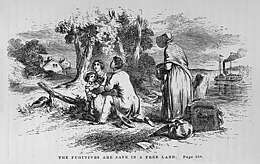
Uncle Tom's Cabin is dominated by a single theme: the evil and immorality of slavery.[32] While Stowe weaves other subthemes throughout her text, such as the moral authority of motherhood and the redeeming possibilities offered by Christianity,[5] she emphasizes the connections between these and the horrors of slavery. Stowe sometimes changed the story's voice so she could give a "homily" on the destructive nature of slavery[33] (such as when a white woman on the steamboat carrying Tom further south states, "The most dreadful part of slavery, to my mind, is its outrages of feelings and affections—the separating of families, for example.").[34] One way Stowe showed the evil of slavery[26] was how this "peculiar institution" forcibly separated families from each other.[35] One of the subthemes presented in the novel is temperance. Stowe made it somewhat subtle and in some cases she weaved it into events that would also support the dominant theme. One example of this is when Augustine St. Clare is killed, he attempted to stop a brawl between two inebriated men in a cafe and was stabbed. One other example is the death of the slave woman Prue who was whipped to death for being drunk on a consistent basis; however, her reasons for doing so is due to the loss of her baby. In the opening of the novel, the fates of Eliza and her son are being discussed between slave owners over wine. Considering that Stowe intended this to be a subtheme, this scene could foreshadow future events that put alcohol in a bad light.
Because Stowe saw motherhood as the "ethical and structural model for all of American life"[36] and also believed that only women had the moral authority to save[37] the United States from the demon of slavery, another major theme of Uncle Tom's Cabin is the moral power and sanctity of women. Through characters like Eliza, who escapes from slavery to save her young son (and eventually reunites her entire family), or Eva, who is seen as the "ideal Christian",[38] Stowe shows how she believed women could save those around them from even the worst injustices. While later critics have noted that Stowe's female characters are often domestic clichés instead of realistic women,[39] Stowe's novel "reaffirmed the importance of women's influence" and helped pave the way for the women's rights movement in the following decades.[40]
Stowe's puritanical religious beliefs show up in the novel's final, overarching theme—the exploration of the nature of Christianity[5] and how she feels Christian theology is fundamentally incompatible with slavery.[41] This theme is most evident when Tom urges St. Clare to "look away to Jesus" after the death of St. Clare's beloved daughter Eva. After Tom dies, George Shelby eulogizes Tom by saying, "What a thing it is to be a Christian."[42] Because Christian themes play such a large role in Uncle Tom's Cabin—and because of Stowe's frequent use of direct authorial interjections on religion and faith—the novel often takes the "form of a sermon."[43]
Style
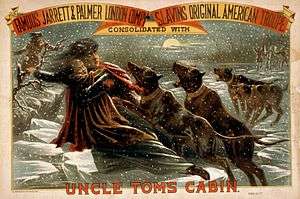
Uncle Tom's Cabin is written in the sentimental[44] and melodramatic style common to 19th-century sentimental novels[8] and domestic fiction (also called women's fiction). These genres were the most popular novels of Stowe's time and tended to feature female main characters and a writing style which evoked a reader's sympathy and emotion.[45] Even though Stowe's novel differs from other sentimental novels by focusing on a large theme like slavery and by having a man as the main character, she still set out to elicit certain strong feelings from her readers.[46] The power in this type of writing can be seen in the reaction of contemporary readers. Georgiana May, a friend of Stowe's, wrote a letter to the author, saying: "I was up last night long after one o'clock, reading and finishing Uncle Tom's Cabin. I could not leave it any more than I could have left a dying child."[47] Another reader is described as obsessing on the book at all hours and having considered renaming her daughter Eva.[48] Evidently the death of Little Eva affected a lot of people at that time, because in 1852, 300 baby girls in Boston alone were given that name.[48]
Despite this positive reaction from readers, for decades literary critics dismissed the style found in Uncle Tom's Cabin and other sentimental novels because these books were written by women and so prominently featured "women's sloppy emotions."[49] One literary critic said that had the novel not been about slavery, "it would be just another sentimental novel,"[50] while another described the book as "primarily a derivative piece of hack work."[51] In The Literary History of the United States, George F. Whicher called Uncle Tom's Cabin "Sunday-school fiction", full of "broadly conceived melodrama, humor, and pathos."[52]
However, in 1985 Jane Tompkins expressed a different view of Uncle Tom's Cabin with her book In Sensational Designs: The Cultural Work of American Fiction.[49] Tompkins praised the style so many other critics had dismissed, writing that sentimental novels showed how women's emotions had the power to change the world for the better. She also said that the popular domestic novels of the 19th century, including Uncle Tom's Cabin, were remarkable for their "intellectual complexity, ambition, and resourcefulness"; and that Uncle Tom's Cabin offers a "critique of American society far more devastating than any delivered by better-known critics such as Hawthorne and Melville."[52]
This view remains the subject of dispute. Writing in 2001, legal scholar Richard Posner described Uncle Tom's Cabin as part of the mediocre list of canonical works that emerges when political criteria are imposed on literature.[53]
Reactions to the novel
Uncle Tom's Cabin has exerted an influence equaled by few other novels in history.[54] Upon publication, Uncle Tom's Cabin ignited a firestorm of protest from defenders of slavery (who created a number of books in response to the novel) while the book elicited praise from abolitionists. As a best-seller, the novel heavily influenced later protest literature.
Contemporary and world reaction
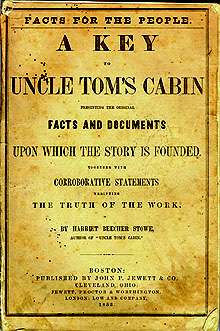
Uncle Tom's Cabin outraged people in the American South.[26] The novel was also roundly criticized by slavery supporters.
Acclaimed Southern novelist William Gilmore Simms declared the work utterly false,[55] while others called the novel criminal and slanderous.[56] Reactions ranged from a bookseller in Mobile, Alabama, being forced to leave town for selling the novel[26] to threatening letters sent to Stowe (including a package containing a slave's severed ear).[26] Many Southern writers, like Simms, soon wrote their own books in opposition to Stowe's novel.[57]
Some critics highlighted Stowe's paucity of life-experience relating to Southern life, saying that it led her to create inaccurate descriptions of the region. For instance, she had never been to a Southern plantation. However, Stowe always said she based the characters of her book on stories she was told by runaway slaves in Cincinnati. It is reported that "She observed firsthand several incidents which galvanized her to write [the] famous anti-slavery novel. Scenes she observed on the Ohio River, including seeing a husband and wife being sold apart, as well as newspaper and magazine accounts and interviews, contributed material to the emerging plot."[58]
In response to these criticisms, in 1853 Stowe published A Key to Uncle Tom's Cabin, an attempt to document the veracity of the novel's depiction of slavery. In the book, Stowe discusses each of the major characters in Uncle Tom's Cabin and cites "real life equivalents" to them while also mounting a more "aggressive attack on slavery in the South than the novel itself had."[21] Like the novel, A Key to Uncle Tom's Cabin was a best-seller. However, while Stowe claimed A Key to Uncle Tom's Cabin documented her previously consulted sources, she actually read many of the cited works only after the publication of her novel.[21] A major part of the Key was Stowe's critique of how the legal system supported slavery and licensed owners' mistreatment of slaves. Thus, Stowe put more than slavery on trial; she put the law on trial. This continued an important theme of Uncle Tom's Cabin—that the shadow of law brooded over the institution of slavery and allowed owners to mistreat slaves and then avoid punishment for their mistreatment. In some cases, as Stowe pointed out, it even prevented kind owners from freeing their slaves.[56]
Despite these criticisms, the novel still captured the imagination of many Americans. According to Stowe's son, when Abraham Lincoln met her in 1862 Lincoln commented, "So this is the little lady who started this great war."[12] Historians are undecided if Lincoln actually said this line, and in a letter that Stowe wrote to her husband a few hours after meeting with Lincoln no mention of this comment was made.[59] Since then, many writers have credited this novel with focusing Northern anger at the injustices of slavery and the Fugitive Slave Law[59] and helping to fuel the abolitionist movement.[9] Union general and politician James Baird Weaver said that the book convinced him to become active in the abolitionist movement.[60]
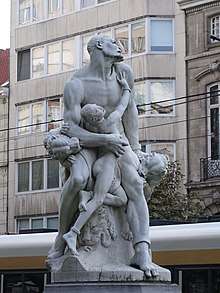
Uncle Tom's Cabin also created great interest in the United Kingdom. The first London edition appeared in May 1852 and sold 200,000 copies.[26] Some of this interest was because of British antipathy to America. As one prominent writer explained, "The evil passions which Uncle Tom gratified in England were not hatred or vengeance [of slavery], but national jealousy and national vanity. We have long been smarting under the conceit of America—we are tired of hearing her boast that she is the freest and the most enlightened country that the world has ever seen. Our clergy hate her voluntary system—our Tories hate her democrats—our Whigs hate her parvenus—our Radicals hate her litigiousness, her insolence, and her ambition. All parties hailed Mrs. Stowe as a revolter from the enemy."[61] Charles Francis Adams, the American minister to Britain during the war, argued later that "Uncle Tom's Cabin; or Life among the Lowly, published in 1852, exercised, largely from fortuitous circumstances, a more immediate, considerable and dramatic world-influence than any other book ever printed."[62]
A French edition, translated by M. L. Carion (or by [Anne-]Louise Swanton-Belloc?, 1796–1881), appeared by 1853 published in Cambrai and in Paris.[63] By 1857, the novel had been translated into 20 languages,[64] including two independent translations into Slovene just one year after its original publication,[65] which started the since-then uninterrupted dialogue between American authors and Slovene translators and readers.[66] Later, it was translated into almost every major language, including Chinese (with translator Lin Shu creating the first Chinese translation of an American novel in 1901) and Amharic (with the 1930 translation created in support of Ethiopian efforts to end the suffering of blacks in that nation).[67] The book was so widely read that Sigmund Freud reported a number of patients with sado-masochistic tendencies who he believed had been influenced by reading about the whipping of slaves in Uncle Tom's Cabin.[68] A short article which was published in the official newspaper of the Salvadoran government on July 22, 1853 praised Harriet Beecher Stowe and her book's success.[69] Influenced by the literature of protest, Ayatollah Sayyid Ali Khamenei, current leader of Islamic Republic of Iran, addressing a number of Iranian intellectuals, remembered the novel as one of the most tragic works in the modern world depicting a morbid history of slavery in America.[70]
Literary significance and criticism
As the first widely read political novel in the United States,[71] Uncle Tom's Cabin greatly influenced development of not only American literature but also protest literature in general. Later books which owe a large debt to Uncle Tom's Cabin include The Jungle by Upton Sinclair and Silent Spring by Rachel Carson.[72] Despite this undisputed significance, Uncle Tom's Cabin has been called "a blend of children's fable and propaganda."[73] The novel has also been dismissed by a number of literary critics as "merely a sentimental novel,"[50] while critic George Whicher stated in his Literary History of the United States that "Nothing attributable to Mrs. Stowe or her handiwork can account for the novel's enormous vogue; its author's resources as a purveyor of Sunday-school fiction were not remarkable. She had at most a ready command of broadly conceived melodrama, humor, and pathos, and of these popular sentiments she compounded her book."[52] Other critics, though, have praised the novel. Edmund Wilson stated that "To expose oneself in maturity to Uncle Tom's Cabin may ... prove a startling experience."[73] Jane Tompkins states that the novel is one of the classics of American literature and wonders if many literary critics dismiss the book because it was simply too popular during its day.[52]
Over the years scholars have postulated a number of theories about what Stowe was trying to say with the novel (aside from the obvious themes, such as condemning slavery). For example, as an ardent Christian and active abolitionist, Stowe placed many of her religious beliefs into the novel.[74] Some scholars have stated that Stowe saw her novel as offering a solution to the moral and political dilemma that troubled many slavery opponents: whether engaging in prohibited behavior was justified in opposing evil. Was the use of violence to oppose the violence of slavery and the breaking of proslavery laws morally defensible? Which of Stowe's characters should be emulated, the passive Uncle Tom or the defiant George Harris?[75] Stowe's solution was similar to Ralph Waldo Emerson's: God's will would be followed if each person sincerely examined his principles and acted on them.[75]
Scholars have also seen the novel as expressing the values and ideas of the Free Will Movement.[76] In this view, the character of George Harris embodies the principles of free labor, while the complex character of Ophelia represents those Northerners who condoned compromise with slavery. In contrast to Ophelia is Dinah, who operates on passion. During the course of the novel Ophelia is transformed, just as the Republican Party (three years later) proclaimed that the North must transform itself and stand up for its antislavery principles.[76]
Feminist theory can also be seen at play in Stowe's book, with the novel as a critique of the patriarchal nature of slavery.[77] For Stowe, blood relations rather than paternalistic relations between masters and slaves formed the basis of families. Moreover, Stowe viewed national solidarity as an extension of a person's family, thus feelings of nationality stemmed from possessing a shared race. Consequently, she advocated African colonization for freed slaves and not amalgamation into American society.
The book has also been seen as an attempt to redefine masculinity as a necessary step toward the abolition of slavery.[78] In this view, abolitionists had begun to resist the vision of aggressive and dominant men that the conquest and colonization of the early 19th century had fostered. In order to change the notion of manhood so that men could oppose slavery without jeopardizing their self-image or their standing in society, some abolitionists drew on principles of women's suffrage and Christianity as well as passivism, and praised men for cooperation, compassion, and civic spirit. Others within the abolitionist movement argued for conventional, aggressive masculine action. All the men in Stowe's novel are representations of either one kind of man or the other.[78]
George Orwell is his essay "Good Bad Books", first published in Tribune on 2 November 1945, claims that "perhaps the supreme example of the 'good bad' book is Uncle Tom's Cabin. It is an unintentionally ludicrous book, full of preposterous melodramatic incidents; it is also deeply moving and essentially true; it is hard to say which quality outweighs the other." But he concludes "I would back Uncle Tom's Cabin to outlive the complete works of Virginia Woolf or George Moore, though I know of no strictly literary test which would show where the superiority lies."
James Baldwin described Uncle Tom's Cabin as, "a bad novel, having, in its self-righteousness, virtuous sentimentality".[79] He argued that the novel lacked psychological depth, and that Stowe, "was not so much a novelist as an impassioned pamphleteer".[80]
Creation and popularization of stereotypes
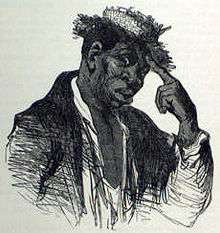
Some modern scholars and readers have criticized the book for condescending racist descriptions of the black characters' appearances, speech, and behavior, as well as the passive nature of Uncle Tom in accepting his fate.[81] The novel's creation and use of common stereotypes about African Americans[14] is significant because Uncle Tom's Cabin was the best-selling novel in the world during the 19th century.[7] As a result, the book (along with illustrations from the book[82] and associated stage productions) was accused of playing a major role in permanently ingraining such stereotypes into the American psyche.[81] In the 1960s and 1970s, the Black Power and Black Arts Movements attacked the novel, claiming that the character of Uncle Tom engaged in "race betrayal", and that Tom made slaves out to be worse than slave owners.[83]
Among the stereotypes of blacks in Uncle Tom's Cabin are[15] the "happy darky" (in the lazy, carefree character of Sam); the light-skinned tragic mulatto as a sex object (in the characters of Eliza, Cassy, and Emmeline); the affectionate, dark-skinned female mammy (through several characters, including Mammy, a cook at the St. Clare plantation); the pickaninny stereotype of black children (in the character of Topsy); the Uncle Tom, an African American who is too eager to please white people. Stowe intended Tom to be a "noble hero" and a Christ-like figure who, like Jesus at his crucifixion, forgives the people responsible for his death. The false stereotype of Tom as a "subservient fool who bows down to the white man", and the resulting derogatory term "Uncle Tom", resulted from staged "Tom Shows", which sometimes replaced Tom's grim death with an upbeat ending where Tom causes his oppressors to see the error of their ways, and they all reconcile happily. Stowe had no control over these shows and their alteration of her story.[28]
These negative associations have to some extent obscured the historical impact of Uncle Tom's Cabin as a "vital antislavery tool".[15] James Baldwin, in a 1949 essay "Everybody's Protest Novel", called Uncle Tom's Cabin a "very bad novel" ... "ruined by its "self-righteous, virtuous sentimentality", and stated that Stowe was less a novelist than an "impassioned pamphleteer", i.e., a propagandist for the antislavery cause.[83] Edward Rothstein has claimed that Baldwin missed the point and that the purpose of the novel was "to treat slavery not as a political issue but as an individually human one – and ultimately a challenge to Christianity itself";[83] as a propaganda work it need not necessarily be great literature in order to succeed in its goals.
In recent years, however, scholars such as Henry Louis Gates Jr. have re-examined Uncle Tom's Cabin, stating that the book is a "central document in American race relations and a significant moral and political exploration of the character of those relations".[83]
Anti-Tom literature
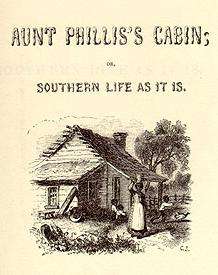
In response to Uncle Tom's Cabin, writers in the Southern United States produced a number of books to rebut Stowe's novel. This so-called Anti-Tom literature generally took a pro-slavery viewpoint, arguing that the issues of slavery as depicted in Stowe's book were overblown and incorrect. The novels in this genre tended to feature a benign white patriarchal master and a pure wife, both of whom presided over childlike slaves in a benevolent extended family style plantation. The novels either implied or directly stated that African Americans were a childlike people[84] unable to live their lives without being directly overseen by white people.[85]
Among the most famous anti-Tom books are The Sword and the Distaff by William Gilmore Simms, Aunt Phillis's Cabin by Mary Henderson Eastman, and The Planter's Northern Bride by Caroline Lee Hentz,[86] with the last author having been a close personal friend of Stowe's when the two lived in Cincinnati. Simms' book was published a few months after Stowe's novel, and it contains a number of sections and discussions disputing Stowe's book and her view of slavery. Hentz's 1854 novel, widely read at the time but now largely forgotten, offers a defense of slavery as seen through the eyes of a Northern woman—the daughter of an abolitionist, no less—who marries a Southern slave owner.
In the decade between the publication of Uncle Tom's Cabin and the start of the American Civil War, between twenty and thirty anti-Tom books were published. Among these novels are two books titled Uncle Tom's Cabin as It Is (one by W. L. Smith and the other by C. H. Wiley) and a book by John Pendleton Kennedy. More than half of these anti-Tom books were written by white women, with Simms commenting at one point about the "Seemingly poetic justice of having the Northern woman (Stowe) answered by a Southern woman."[87]
"Professional racist" Thomas Dixon Jr. saw a dramatic version of the novel and, feeling that it was unfair to the South, wrote The Leopard's Spots (1902) as a reply. He uses characters from Stowe's work: Simon Legree, George Harris, Tim (for Arthur) and George Shelby, and Tom, converted into Tom Camp, a white former Confederate soldier. Dixon is a key figure in popularizing the myth of the Lost Cause of the Confederacy.
Dramatic adaptations
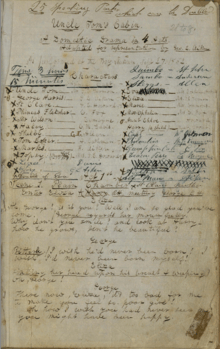
-_group_of_men%2C_two_holding_whips%2C_pointing_at_two_men_and_a_woman_on_snow-covered_bridge_LCCN2004681922.jpg)
-_Little_Eva's_death_scene_LCCN2004681923.jpg)
Plays and Tom shows
Even though Uncle Tom's Cabin was the best-selling novel of the 19th century, far more Americans of that time saw the story as a stage play or musical than read the book.[88] Eric Lott, in his book Uncle Tomitudes: Racial Melodrama and Modes of Production, estimates that at least three million people saw these plays, ten times the book's first-year sales.
Given the lax copyright laws of the time, stage plays based on Uncle Tom's Cabin—"Tom shows"—began to appear while the novel was still being serialized. Stowe refused to authorize dramatization of her work because of her distrust of drama (although she did eventually go to see George L. Aiken's version and, according to Francis Underwood, was "delighted" by Caroline Howard's portrayal of Topsy).[89] Aiken's stage production was the most popular play in the U.S. and England for 75 years.[90] Stowe's refusal to authorize a particular dramatic version left the field clear for any number of adaptations, some launched for (various) political reasons and others as simply commercial theatrical ventures.
No international copyright laws existed at the time. The book and plays were translated into several languages; Stowe received no money, which could have meant as much as "three-fourths of her just and legitimate wages."[91]
All of the Tom shows appear to have incorporated elements of melodrama and blackface minstrelsy.[92] These plays varied tremendously in their politics—some faithfully reflected Stowe's sentimentalized antislavery politics, while others were more moderate, or even pro-slavery.[89] Many of the productions featured demeaning racial caricatures of Black people,[92] while a number of productions also featured songs by Stephen Foster (including "My Old Kentucky Home", "Old Folks at Home", and "Massa's in the Cold Ground").[88] The best-known Tom Shows were those of George Aiken and H.J. Conway.[89]
The version by Aiken is perhaps the best known stage adaptation, released just a few months after the novel was published. This six-act behemoth also set an important precedent by being the first show on Broadway to stand on its own, without the performance of other entertainments or any afterpiece.[93] Most of Aiken's dialogue was taken verbatim from Stowe's novel, and his adaptation included four full musical numbers written by the producer, George C. Howard.[94] Another legacy of Aiken's version is its reliance upon very different locations all portrayed on the same stage. This reliance led to large sets and set a precedent for the future days of film.[95] By focusing on the stark and desperate situations of his characters, Aiken appealed to the emotions of his audiences.[96] By combining this melodramatic approach with the content of Stowe's novel, Aiken helped to create a powerful visual indictment against the institution of slavery.
The many stage variants of Uncle Tom's Cabin "dominated northern popular culture... for several years" during the 19th century,[89] and the plays were still being performed in the early 20th century.
One of the unique and controversial variants of the Tom Shows was Walt Disney's Mickey's Mellerdrammer, a United Artists film released in 1933. The title is a corruption of "melodrama", thought to harken back to the earliest minstrel shows, as a film short based on a production of Uncle Tom's Cabin by the Disney characters. In that film, Mickey Mouse and friends stage their own production of Uncle Tom's Cabin. Mickey Mouse was already black-colored, but the advertising poster for the film shows Mickey dressed in blackface with exaggerated, orange lips; bushy, white sidewhiskers made out of cotton; and his trademark white gloves.
Films
Uncle Tom's Cabin has been adapted several times as a film. Most of these movies were created during the silent film era (Uncle Tom's Cabin was the most-filmed book of that time period).[97] Because of the continuing popularity of both the book and "Tom" shows, audiences were already familiar with the characters and the plot, making it easier for the film to be understood without spoken words.[97] There has been no Hollywood treatment since the end of the silent era.
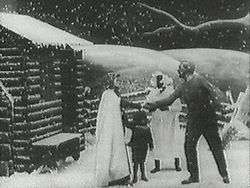
The first film version of Uncle Tom's Cabin was one of the earliest full-length movies (although full-length at that time meant between 10 and 14 minutes).[98] This 1903 film, directed by Edwin S. Porter, used white actors in blackface in the major roles and black performers only as extras. This version was evidently similar to many of the "Tom Shows" of earlier decades and featured numerous stereotypes about blacks (such as having the slaves dance in almost any context, including at a slave auction).[98]
In 1910, a three-reel Vitagraph Company of America production was directed by J. Stuart Blackton and adapted by Eugene Mullin. According to The Dramatic Mirror, this film was "a decided innovation" in motion pictures and "the first time an American company" released a dramatic film in three reels. Until then, full-length movies of the time were 15 minutes long and contained only one reel of film. The movie starred Florence Turner, Mary Fuller, Edwin R. Phillips, Flora Finch, Genevieve Tobin and Carlyle Blackwell, Sr.[99]
At least four more movie adaptations were created in the next two decades. The last silent film version was released in 1927. Directed by Harry A. Pollard (who played Uncle Tom in a 1913 release of Uncle Tom's Cabin), this two-hour movie was more than a year in production and was the third most expensive picture of the silent era (at a cost of $1.8 million). The black actor Charles Gilpin was originally cast in the title role, but he was fired after the studio decided his "portrayal was too aggressive."[100] James B. Lowe took over the character of Tom. The screenplay takes many liberties with the original book, including altering the Eliza and George subplot, introducing the Civil War and Emancipation, and combining the characters of Eliza and Emmeline.[100] Another difference occurs after Tom dies: Simon Legree is haunted by an apparitional vision of the late Tom and falls to his death in a futile effort to attack the ghostly image.
Black media outlets of the time praised the film, but the studio—fearful of a backlash from Southern and white film audiences—ended up cutting out controversial scenes, including the film's opening sequence at a slave auction (in which a mother is torn away from her baby).[101] The story was adapted by Harvey F. Pollard, Thew and A. P. Younger, with titles by Walter Anthony. It starred James B. Lowe, Virginia Grey, George Siegmann, Margarita Fischer, Mona Ray and Madame Sul-Te-Wan.[100]
For several decades after the end of the silent film era, the subject matter of Stowe's novel was judged too sensitive for further film interpretation. In 1946, Metro-Goldwyn-Mayer considered filming the story but ceased production after protests led by the National Association for the Advancement of Colored People.[102]
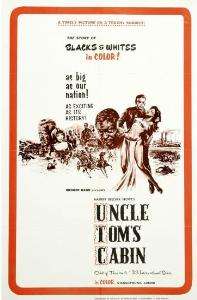
A German-language version, Onkel Toms Hütte, directed by Géza von Radványi, was released in 1965 and was presented in the United States by exploitation film presenter Kroger Babb.
The most recent film version was a television broadcast in 1987, directed by Stan Lathan and adapted by John Gay. It starred Avery Brooks, Phylicia Rashad, Edward Woodward, Jenny Lewis, Samuel L. Jackson and Endyia Kinney.
In addition to film adaptations, versions of Uncle Tom's Cabin have been produced in other formats. In Brazil, the adapted version A Cabana do Pai Tomás was produced as a TV soap opera by Rede Globo; with 205 episodes, it was aired from July 1969 to March 1970.
Versions of Uncle Tom's Cabin were featured in a number of animated cartoons, including Walt Disney's "Mickey's Mellerdrammer" (1933), which features Mickey Mouse performing the play in blackface with large orange lips; "Uncle Tom's Bungalow" (1937), a Warner Brother's cartoon supervised by Tex Avery; "Eliza on Ice" (1944), one of the earliest Mighty Mouse cartoons produced by Paul Terry; "Uncle Tom's Cabana" (1947), a six-minute cartoon directed by Tex Avery, and the Bugs Bunny cartoon "Southern Fried Rabbit" (1953), wherein Bugs disguises himself as Uncle Tom and sings "My Old Kentucky Home" in order to cross the Mason-Dixon line.[102]
Uncle Tom's Cabin has influenced numerous movies, including The Birth of a Nation. This controversial 1915 film set the dramatic climax in a slave cabin similar to that of Uncle Tom, where several white Southerners unite with their former enemy (Yankee soldiers) to defend, according to the film's caption, their "Aryan birthright." According to scholars, this reuse of such a familiar image of a slave cabin would have resonated with, and been understood by, audiences of the time.[103]
Other movies influenced by or making use of Uncle Tom's Cabin include Dimples, a 1936 Shirley Temple film;[102] Uncle Tom's Uncle, a 1926 Our Gang film;[102] its 1932 remake Spanky; the Rodgers and Hammerstein musical The King and I, in which a ballet called "Small House of Uncle Thomas" is performed in traditional Siamese style; and Gangs of New York, in which Leonardo DiCaprio and Daniel Day-Lewis's characters attend an imagined wartime adaptation of Uncle Tom's Cabin.
See also
- Twelve Years a Slave (1853), bestselling narrative of free negro Solomon Northup published soon after Uncle Tom's Cabin (1852), which documents facts supporting Stowe's fictional narrative in detail, as the area where Northup was enslaved was close to the fictional setting of the plantation where much of Stowe's narrative takes place.[104][105]
- History of slavery in the United States
- Origins of the American Civil War
- Mary Mildred Williams
- Ramona, an 1884 novel that attempted to do for Native Americans in California what Uncle Tom's Cabin had done for African Americans
- Riley-Bolten House, North Bethesda, Montgomery County, Maryland, plantation house of Isaac Riley listed on the National Register of Historic Places
- Timeline of the civil rights movement
Collections
Major collections of Uncle Tom's Cabin books, ephemera, and artifacts reside at the Albert and Shirley Small Special Collections Library at the University of Virginia and the Harry Ransom Center at the University of Texas at Austin.
Notes
- Beecher Stowe, Harriet (1852). Uncle Tom's Cabin; or, Life Among the Lowly. I. Boston: John P. Jewitt. Retrieved June 14, 2012.
- Beecher Stowe, Harriet (1852). Uncle Tom's Cabin; or, Life Among the Lowly. II. Boston: John P. Jewitt. Retrieved October 29, 2013.
- Kaufman, Will (2006). The Civil War in American Culture. Edinburgh University Press. p. 18. ISBN 9780748619351.
- Uncle Tom's Cabin by Harriet Beecher Stowe, Spark Publishers, 2002, p. 19, states the novel is about the "destructive power of slavery and the ability of Christian love to overcome it..."
- Laurie E. Rozakis, The Complete Idiot's Guide to American Literature, Alpha Books, 1999, p. 125, says one of the book's main messages is that "The slavery crisis can only be resolved by Christian love."
- Deborah C. de Rosa, Domestic Abolitionism and Juvenile Literature, 1830–1865, SUNY Press, 2003, p. 121. De Rosa quotes Jane Tompkins that Stowe's strategy was to destroy slavery through the "saving power of Christian love." This quote is from "Sentimental Power: Uncle Tom's Cabin and the Politics of Literary History" Archived December 16, 2007, at the Wayback Machine by Jane Tompkins, from In Sensational Designs: The Cultural Work of American Fiction, 1790–1860. New York: Oxford University Press, 1985. pp. 122–146. In that essay, Tompkins also writes: "Stowe conceived her book as an instrument for bringing about the day when the world would be ruled not by force, but by Christian love."
- "Introduction to Uncle Tom's Cabin Study Guide". BookRags.com. Retrieved May 16, 2006.
- "The Sentimental Novel: The Example of Harriet Beecher Stowe" by Gail K. Smith, The Cambridge Companion to Nineteenth-Century American Women's Writing by Dale M. Bauer and Philip Gould, Cambridge University Press, 2001, p. 221. Book preview.
- Goldner, Ellen J. "Arguing with Pictures: Race, Class and the Formation of Popular Abolitionism Through Uncle Tom's Cabin." Journal of American & Comparative Cultures 2001 24(1–2): 71–84. ISSN 1537-4726 Fulltext: online at Ebsco.
- Geoffrey Wheatcroft, "The Cousins' War: review of Amanda Foreman, 'A World on Fire'", New York Times Book Review, July 3, 2011, p. 1
- Everon, Ernest. "Some Thoughts Anent Dickens and Novel Writing" The Ladies' Companion and Monthly Magazine London, 1855 Volume VII Second Series:259.
- Charles Edward Stowe, Harriet Beecher Stowe: The Story of Her Life (1911) p. 203.
- Vollaro, Daniel R. (Winter 2009), Lincoln, Stowe, and the "Little Woman/Great War" Story: The Making, and Breaking, of a Great American Anecdote, 30, Journal of the Abraham Lincoln Association, archived from the original on October 15, 2009
- Hulser, Kathleen. "Reading Uncle Tom's Image: From Anti-slavery Hero to Racial Insult." New-York Journal of American History 2003 65(1): 75–79. ISSN 1551-5486.
- Henry Louis Gates, Kwame Anthony Appiah, Africana: Arts and Letters: An A-to-Z Reference of Writers, Musicians, and Artists of the African American Experience, Running Press, 2005, p. 544.
- Susan Logue, "Historic Uncle Tom's Cabin Saved" Archived January 30, 2012, at the Wayback Machine, VOA News, January 12, 2006. Retrieved December 24, 2011.
- Harriet Beecher Stowe, A Key to Uncle Tom's Cabin 1853, p. 42, in which Stowe states: "A last instance parallel with that of Uncle Tom is to be found in the published memoirs of the venerable Josiah Henson]..." This also is cited in Debra J. Rosenthal, A Routledge Literary Sourcebook on Harriet Beecher Stowe's Uncle Tom's Cabin, Routledge, 2003, pp. 25–26.
- Annys Shin, "After buying historic home, Md. officials find it wasn't really Uncle Tom's Cabin", The Washington Post, October 3, 2010.
- Official Montgomery Parks Josiah Henson Park site
- "Weld, Theodore Dwight". Archived from the original on February 25, 2009. Retrieved May 15, 2007.The Columbia Encyclopedia, Sixth Edition, 2001–2005.
- The Key to Uncle Tom's Cabin, Uncle Tom's Cabin and American Culture, a Multi-Media Archive. Retrieved April 20, 2007.
- Applegate, Debby (2006). The Most Famous Man in America: The Biography of Henry Ward Beecher. New York: Three Leaves Press. p. 261.
- First Edition Illustrations, Uncle Tom's Cabin and American Culture, a Multi-Media Archive. Retrieved April 18, 2007.
- Illustrations for the "Splendid Edition", Uncle Tom's Cabin and American Culture, a Multi-Media Archive. Retrieved April 18, 2007.
- Michael Winship, "Uncle Tom's Cabin: History of the Book in the 19th-Century United States."
- "Slave narratives and Uncle Tom's Cabin", Africans in America, PBS. Retrieved February 16, 2007.
- "publishing, history of." (2007). In Encyclopædia Britannica. Retrieved April 18, 2007, from Encyclopædia Britannica Online.
- Debra J. Rosenthal, A Routledge Literary Sourcebook on Harriet Beecher Stowe's Uncle Tom's Cabin, Routledge, 2003, p. 31.
- Hagedorn, Ann. Beyond The River: The Untold Story of the Heroes of the Underground Railroad. Simon & Schuster, 2002, pp. 135–139.
- J. E. Dunn (August 31, 1896). "About Uncle Tom's Cabin: A Louisianian Says Meredith Calhoun Was Not a Model for Legree". The Washington Post. Retrieved December 23, 2010.
- The Word Detective Archived May 8, 2008, at the Wayback Machine , issue of May 20, 2003. Retrieved February 16, 2007.
- Homelessness in American Literature: Romanticism, Realism, and Testimony by John Allen, Routledge, 2004, p. 24, where it states in regards to Uncle Tom's Cabin that "Stowe held specific beliefs about the 'evils' of slavery and the role of Americans in resisting it." The book then quotes Ann Douglas describing how Stowe saw slavery as a sin.
- Drawn With the Sword: Reflections on the American Civil War by James Munro McPherson, Oxford University Press, 1997, p. 30.
- Uncle Tom's Cabin by Harriet Beecher Stowe, Vintage Books, Modern Library Edition, 1991, p. 150.
- James Munro McPherson, Drawn With the Sword: Reflections on the American Civil War, Oxford University Press, 1997, p. 29.
- Elizabeth Ammons, "Stowe's Dream of the Mother-Savior: Uncle Tom's Cabin and American Women Writers Before the 1920s", in Eric J. Sundquist (ed.), New Essays on Uncle Tom's Cabin, Cambridge University Press, 1986, p. 159.
- Joy Jordan-Lake, Whitewashing Uncle Tom's Cabin: Nineteenth-Century Women Novelists Respond to Stowe, Vanderbilt University Press, 2005, p. 61.
- Somatic Fictions: imagining illness in Victorian culture by Athena Vrettos, Stanford University Press, 1995, p. 101.
- Mason I. Lowance, Jr., Ellen E. Westbrook, R. C. De Prospo, The Stowe Debate: Rhetorical Strategies in Uncle Tom's Cabin, University of Massachusetts Press, 1994, p. 132.
- Linda Eisenmann, Historical Dictionary of Women's Education in the United States, Greenwood Press, 1998, p. 3.
- David L. Larsen, The Company of the Creative: A Christian Reader's Guide to Great Literature and Its Themes, Kregel Publications, 2000, pp. 386–387.
- Larsen, The Company of the Creative (2000), p. 387.
- Sacvan Bercovitch and Cyrus R. K. Patell, The Cambridge History of American Literature, Cambridge University Press, 1994, p. 119.
- Marianne Noble, "The Ecstasies of Sentimental Wounding in Uncle Tom's Cabin," from Debra J. Rosenthal (ed.), A Routledge Literary Sourcebook on Harriet Beecher Stowe's Uncle Tom's Cabin, Routledge, 2003, p. 58.
- "Domestic or Sentimental Fiction, 1820–1865" American Literature Sites, Washington State University. Retrieved April 26, 2007.
- "Uncle Tom's Cabin" Archived August 27, 2008, at the Wayback Machine , The Kansas Territorial Experience. Retrieved April 26, 2007.
- Janet Badia and Jennifer Phegley, Reading Women: Literary Figures and Cultural Icons from the Victorian Age to the Present, University of Toronto Press, 2005, p. 67.
- Badia and Phegley, Reading Women (2005), p. 66.
- Rosenthal, A Routledge Literary Sourcebook on Harriet Beecher Stowe's Uncle Tom's Cabin (2003), p. 42.
- Thomas F. Gossett, "Review of The Building of Uncle Tom's Cabin by E. Bruce Kirkham", American Literature, Vol. 50, No. 1 (March 1978), pp. 123–124.
- Charles Nichols, "The Origins of Uncle Tom's Cabin", The Phylon Quarterly, Vol. 19, No. 3 (3rd Qtr, 1958), p. 328.
- Jane Tompkins, "Sentimental Power: Uncle Tom's Cabin and the Politics of Literary History" Archived December 16, 2007, at the Wayback Machine , from In Sensational Designs: The Cultural Work of American Fiction, 1790–1860. New York: Oxford University Press, 1985, pp. 122–146.
- Posner, R., Public Intellectuals: A Study of Decline, Harvard University Press (2002), p. 239. ISBN 0-674-00633-X.
- Hollis Robbins, Uncle Tom's Cabin and the Matter of Influence", Gilder Lehrman Institute of American History. Retrieved December 24, 2011.
- "Simms's Review of Uncle Tom's Cabin" by Charles S. Watson, American Literature, Vol. 48, No. 3 (November 1976), pp. 365–368
- Alfred L. Brophy, "Over and above ... There Broods a Portentous Shadow,—The Shadow of Law: Harriet Beecher Stowe's Critique of Slave Law in Uncle Tom's Cabin", Journal of Law and Religion, Vol. 12, No. 2 (1995–1996), pp. 457–506.
- Joseph V. Ridgely, "Woodcraft: Simms's First Answer to Uncle Tom's Cabin", American Literature, Vol. 31, No. 4 (January 1960), pp. 421–433.
- The Classic Text: Harriett Beecher Stowe. University of Wisconsin-Milwaukee Library. Special collection page on traditions and interpretations of Uncle Tom's Cabin. Retrieved May 15, 2007. Archived May 16, 2008, at the Wayback Machine
- Uncle Tom's Cabin, introduction by Amanda Claybaugh, Barnes and Noble Classics, New York, 2003, p. xvii.
- A. M. Arnett, "Review of James Baird Weaver by Fred Emory Haynes", Political Science Quarterly, Vol. 35, No. 1 (March 1920), pp. 154–157; and profile of James Baird Weaver Archived January 2, 2007, at the Wayback Machine . Retrieved February 17, 2007.
- Nassau Senior, quoted in Ephraim Douglass Adams, Great Britain and the American Civil War (1958), p. 33.
- Charles Francis Adams, Trans-Atlantic Historical Solidarity: Lectures Delivered before the University of Oxford in Easter and Trinity Terms, 1913, 1913, p. 79.
- Its title was La Case de l'Oncle Tom, ou Sort des nègres esclaves. Its publication was noted in the weekly periodical Bibliographie de la France ou Journal général de l'Imprimerie et de la Librairie, November 5, 1853, p. 723. See also OCLC 811741 which disagrees as to the translators name – perhaps Carion was a pseudonym.
- "Uncle Tom's Cabin: A 19th-Century Bestseller". The University of Alabama. Retrieved June 14, 2012.
- Drnovšek, Marjan (1998). Usodna privlačnost Amerike: pričevanja izseljencev o prvih stikih z novim svetom [The Fatal Attractiveness of America: The Testimonies of Expatriates About the First Contacts with the New World]. Korenine (in Slovenian). Nova revija. ISBN 978-961-6017-56-5. COBISS 73608960.
- Mazi-Leskovar, Darja (May 2003). "Domestication and Foreignization in Translating American Prose for Slovenian Children". Meta: Translator's Journal. 48 (1–2): 250–265. ISSN 1492-1421.
- Richard Pankhurst, Economic History of Ethiopia (Addis Ababa: Haile Selassie I University Press, 1968), p. 122.
- Gibson, Ian, The English Vice: Beating, Sex and Shame in Victorian England and After (1978) The passage which seems most likely to have interested them is the start of chapter 29.
- "La Cabaña del Tío Tomás" (PDF). Gaceta del Gobierno del Salvador en la América Central (in Spanish). Tomo 4 Número 17. July 22, 1853. p. 4. Archived from the original (PDF) on April 21, 2018. Retrieved April 21, 2018.
- ""Uncle Tom" is still alive in the American society". Khamenei.ir. June 14, 2016. Retrieved September 24, 2019.
- Tompkins, Jane. Sensational Designs: The Cultural Work of American Fiction, 1790–1860. New York: Oxford University Press, 1986. See chapter five, "Sentimental Power: Uncle Tom's Cabin and the Politics of Literary History."
- Cindy Weinstein, The Cambridge Companion to Harriet Beecher Stowe, Cambridge University Press, 2004, p. 13.
- Darryl Lorenzo Wellington, "Uncle Tom's Shadow", The Nation, December 25, 2006.
- Smylie, James H. "Uncle Tom's Cabin Revisited: the Bible, the Romantic Imagination, and the Sympathies of Christ." American Presbyterians 1995 73(3): 165–175. ISSN 0886-5159.
- Bellin, Joshua D. "Up to Heaven's Gate, down in Earth's Dust: the Politics of Judgment in Uncle Tom's Cabin", American Literature 1993 65(2): 275–295. ISSN 0002-9831 Fulltext online at Jstor and Ebsco.
- Grant, David, "Uncle Tom's Cabin and the Triumph of Republican Rhetoric", New England Quarterly 1998 71(3): 429–448. ISSN 0028-4866 Fulltext online at Jstor.
- Riss, Arthur. "Racial Essentialism and Family Values in Uncle Tom's Cabin." American Quarterly 1994 46(4): 513–544. ISSN 0003-0678 Fulltext in JSTOR.
- Wolff, Cynthia Griffin. "Masculinity in Uncle Tom's Cabin," American Quarterly 1995 47(4): 595–618. ISSN 0003-0678. Fulltext online at JSTOR.
- Baldwin, James (November 2, 2017). Notes of a Native Son. Penguin. p. 1. ISBN 978-0-14-198727-9.
- Baldwin, James (November 2, 2017). Notes of a Native Son. Penguin. p. 2. ISBN 978-0-14-198727-9.
- Smith; Jessie Carney; Images of Blacks in American Culture: A Reference Guide to Information Sources Greenwood Press. 1988.
- Illustrations, Uncle Tom's Cabin and American Culture, a Multi-Media Archive. Retrieved April 18, 2007.
- Edward Rothstein, "Digging Through the Literary Anthropology of Stowe's Uncle Tom", The New York Times, October 23, 2006.
- Linda Williams, Playing the Race Card: Melodramas of Black and White from Uncle Tom to O. J. Simpson, Princeton University Press, 2001, p. 113.
- Joy Jordan-Lake, Whitewashing Uncle Tom's Cabin: nineteenth-century women novelists respond to Stowe, Vanderbilt University Press, 2005.
- Beidler, Philip D. (Winter 2005). "Caroline Lee Hentz's Long Journey". Alabama Heritage (75).
- Henry Louis Gates, Figures in Black: words, signs, and the "racial" self, Oxford University Press, 1987, p. 134.
- "People & Events: Uncle Tom's Cabin Takes the Nation by Storm" Archived February 26, 2017, at the Wayback Machine, Stephen Foster – The American Experience, PBS. Retrieved April 19, 2007.
- Lott, Eric, Love and Theft: Blackface Minstrelsy and the American Working Class. New York: Oxford University Press, 1993. ISBN 0-19-507832-2. The information on "Tom shows" comes from chapter 8: "Uncle Tomitudes: Racial Melodrama and Modes of Production" (pp. 211–233)
- Hollis Robbins, "'Uncle Tom's Cabin' and the Matter of Influence", History by Era: Literature and Language Arts, Gilder Lehrman Center. Retrieved June 30, 2012.
- Parton, James (October 1867). "International Copyright". The Atlantic. Retrieved January 6, 2009.
- Henry Louis Gates, Kwame Anthony Appiah, Africana: arts and letters: an A-to-Z reference of writers, musicians, and artists of the African American Experience, Running Press, 2005, p. 44.
- Wilmeth, Don B. (ed.), Staging the Nation: Plays from the American Theater, 1787–1909. Boston: Bedford Books, 1998, p. 181.
- Aiken, George L. Uncle Tom's Cabin. New York: Garland, 1993.
- Gerould, Daniel C. (ed.), American Melodrama. New York: Performing Arts Journal Publications, 1983, p. 16.
- Gerould, American Melodrama (1983), p. 14.
- "Uncle Tom's Cabin on Film" Archived May 10, 2008, at the Wayback Machine, Uncle Tom's Cabin and American Culture, a Multi-Media Archive, University of Virginia. Retrieved April 19, 2007
- "The First Uncle Tom's Cabin Film: Edison-Porter's 'Slavery Days' (1903)" Archived March 13, 2007, at the Wayback Machine, Uncle Tom's Cabin and American Culture, a Multi-Media Archive, University of Virginia. Retrieved April 19, 2007.
- "The 3-Reel Vitagraph Production (1910)" Archived October 13, 2007, at the Wayback Machine, Uncle Tom's Cabin and American Culture, a Multi-Media Archive, University of Virginia. Retrieved April 19, 2007.
- "Universal Super Jewel Production (1927)", Uncle Tom's Cabin and American Culture, a Multi-Media Archive, University of Virginia. Retrieved April 19, 2007.
- Thomas Cripps, Slow Fade to Black: The Negro in American Film, 1900–1942, Oxford University Press, 1993, p. 48.
- "Uncle Tom's Cabin in Hollywood: 1929–1956", Uncle Tom's Cabin and American Culture, a Multi-Media Archive, University of Virginia. Retrieved April 19, 2007.
- Linda Williams, Playing the Race Card (2001), p. 115. Also "H. B. Stowe's Cabin in D. W. Griffith's Movie", Uncle Tom's Cabin and American Culture, a Multi-Media Archive, University of Virginia. Retrieved April 19, 2007.
- Northup, Solomon. Twelve Years a Slave: Summary, online text at Documenting the American South, University of North Carolina. Retrieved July 19, 2012
- "'12 Years a Slave' prompts effort to recognize work of UNO historian in reviving tale". NOLA. Retrieved September 27, 2013.
References
- Aiken, George L. Uncle Tom's Cabin. New York: Garland, 1993.
- Gates, Henry Louis; and Appiah, Kwame Anthony. Africana: Arts and Letters: an A-to-Z reference of writers, musicians, and artists of the African American Experience, Running Press, 2005.
- Gates, Henry Louis; and Hollis Robbins. The Annotated Uncle Tom's Cabin, W. W. Norton. ISBN 0-393-05946-4
- Gerould, Daniel C., ed. American Melodrama. New York: Performing Arts Journal Publications, 1983.
- Jordan-Lake, Joy. Whitewashing Uncle Tom's Cabin: Nineteenth-Century Women Novelists Respond to Stowe, Vanderbilt University Press, 2005.
- Lott, Eric. Love and Theft: Blackface Minstrelsy and the American Working Class. New York: Oxford University Press, 1993.
- Lowance, Mason I. (Jr.); Westbrook, Ellen E.; De Prospo, R., The Stowe Debate: Rhetorical Strategies in Uncle Tom's Cabin, University of Massachusetts Press, 1994.
- Parfait, Claire. The Publishing History of Uncle's Tom's Cabin, 1852–2002, Aldershot: Ashgate, 2007.
- Reynolds, David S. Mightier Than the Sword: Uncle Tom's Cabin and the Battle for America, Norton, 2011. 351 pp.
- Rosenthal, Debra J. Routledge Literary Sourcebook on Harriet Beecher Stowe's Uncle Tom's Cabin, Routledge, 2003.
- Sundquist, Eric J., ed. New Essays on Uncle Tom's Cabin, Cambridge University Press, 1986.
- Tompkins, Jane. In Sensational Designs: The Cultural Work of American Fiction, 1790–1860. New York: Oxford University Press, 1985.
- Weinstein, Cindy. The Cambridge Companion to Harriet Beecher Stowe, Cambridge University Press, 2004.
- Williams, Linda. Playing the Race Card: Melodramas of Black and White from Uncle Tom to O. J. Simpson, Princeton University Press, 2001.
External links
| Wikimedia Commons has media related to Uncle Tom's Cabin. |
| Wikisource has original text related to this article: |
- Uncle Tom's Cabin on In Our Time at the BBC
- University of Virginia Web site "Uncle Tom's Cabin and American Culture: A Multi-Media Archive" – edited by Stephen Railton, covers 1830 to 1930, offering links to primary and bibliographic sources on the cultural background, various editions, and public reception of Harriet Beecher Stowe's influential novel. The site also provides the full text of the book, audio and video clips, and examples of related merchandising.
- Uncle Tom's Cabin: or Life among the lowly; frontispiece by John Gilbert; ornamental title-page by Phiz; and 130 engravings on wood by Matthew Urlwin Sears, 1853 (a searchable facsimile at the University of Georgia Libraries; DjVu & layered PDF format)
- Pictures and stories from Uncle Tom's Cabin; "The purpose of the editor of this little work, has been to adapt it for the juvenile family circle. The verses have accordingly been written by the authoress for the capacity of the youngest readers ..." 1853 (a searchable facsimile at the University of Georgia Libraries; DjVu & layered PDF format)
- Uncle Tom's Cabin at Project Gutenberg
- Uncle Tom's Cabin, available at Internet Archive. Scanned, illustrated original editions.
- Uncle Tom's Cabin Historic Site

- More on the lack of international copyright
- Uncle Tom's Cabin for Children From the Collections at the Library of Congress
- Guide to the Uncle Tom's Cabin Collection 1852-1956 at the University of Chicago Special Collections Research Center
